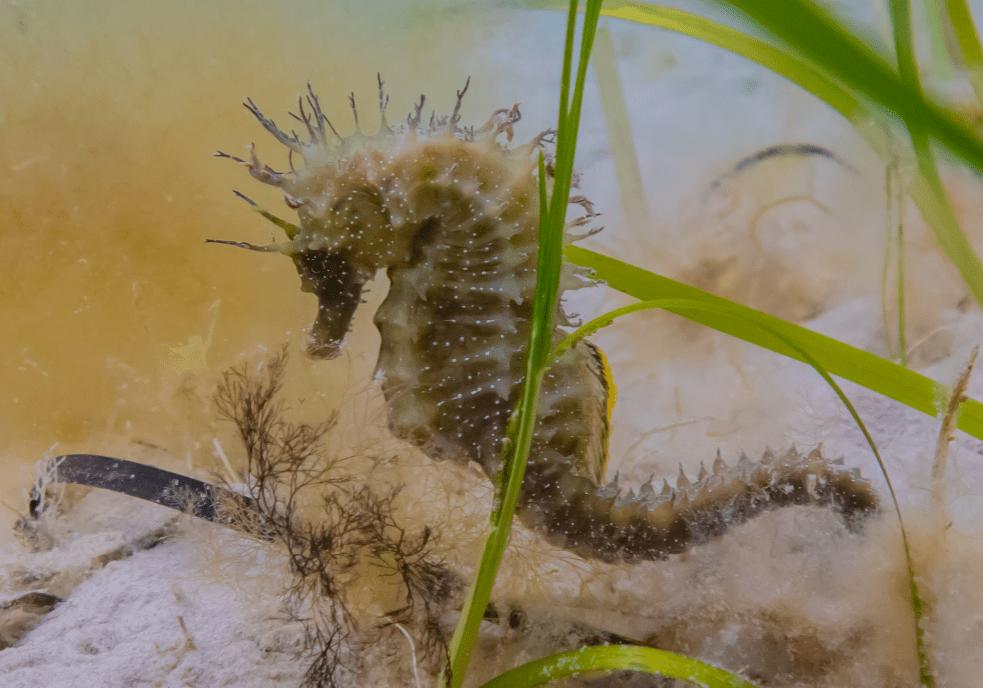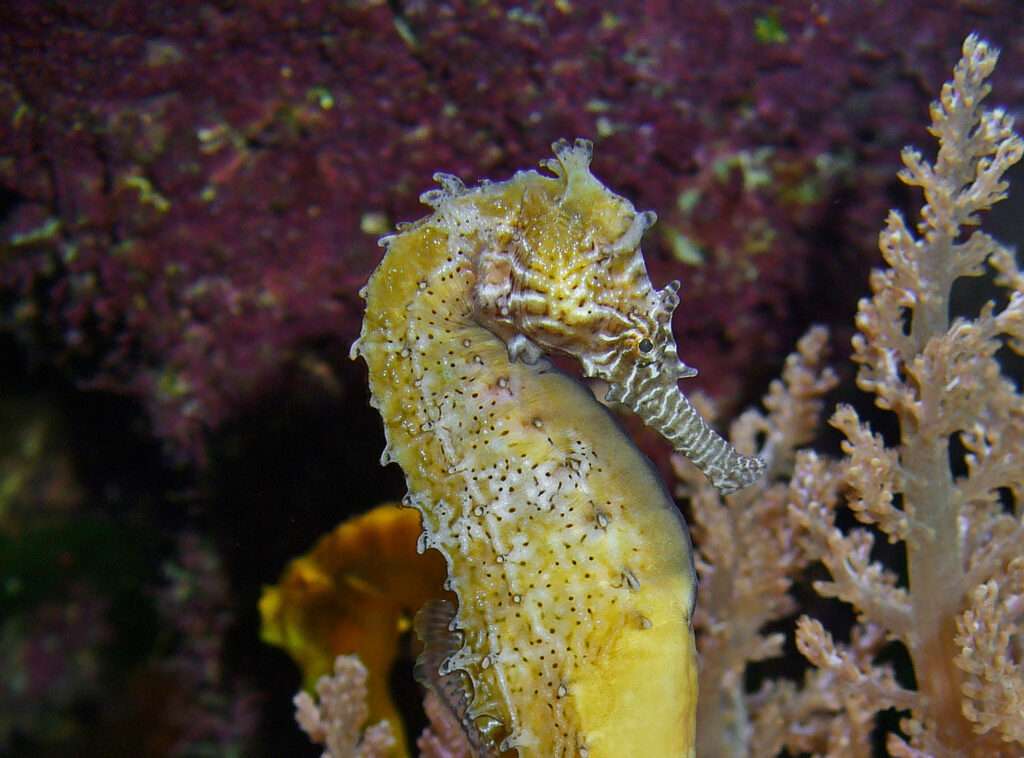
This specie belong to Syngnathidae family is the short-snouted seahorse. In particular, the area around the Canary Islands and the Italy was where it was indigenous to the Mediterranean Sea and some regions of the North Atlantic. Around Southend-on-Sea and London in the River Thames, colonies of the species were found in 2007. Their favored habitats include seagrass beds, estuaries, and shallow muddy seas. One of two seahorse species present in the British Isles is Hippocampus hippocampus. The other is Hippocampus guttulatus, which has a longer snout and elongated protuberances down the back of the neck that resemble a “horse’s mane.” Currently, it is unknown how many seahorses there are in the British Isles and how they are distributed. The Seahorse Trust is actively compiling data for the British Seahorse study.
Habitat
Hippocampus are generally found in murky, shallow water on the bottoms of rocks, at the edge of seagrass beds or in seaweed. They only exist in waters up to a depth of 77 meters (253 feet). They travel very little throughout the day, therefore their home range is very constrained. The majority of their mobility happens during storms, when the seahorses are either carried away by the current or propelled by it while grabbing onto floating debris. To avoid rough seas in the winter, they often go into deeper water. They are excellent at camouflaging and will fasten themselves to plant stems using their tails.
This species and the long-snouted seahorse are primarily found on the southern and western coasts of Britain and Ireland due to the Gulf Stream’s influence on the distribution of warmer waters that increase plankton productivity.
Appearance
The head of the seahorse is positioned at an angle to the body, giving it a highly distinctive shape. While the tail is tapered, coiled, and prehensile, the body’s trunk is short and quite fat. Hippocampus. The hippocampus can grow to a maximum length of 15 cm. Less than one-third the length of the head, the nose is short and upturned. Above each eye is a pronounced spine. The 16–18 rays of the dorsal fin typically have a dark stripe that runs parallel to the margin. There are 13–15 rays on the pectoral fins. Bony tubercles on body rings give them an angular, knobby appearance. The body might be brown, orange, purple, or black, occasionally with light spots.
Feeding
A typical day for an adult seahorse includes between 30 and 50 tiny shrimp. The hippocampi are well known as ambush predators that consume live, moving prey. When a small animal enters their field of vision, they will suddenly start to move and grab it. They utilize their snout to consume food directly because they lack teeth and a stomach. The prey will go quickly through the digestive system because they don’t have stomachs.

Reproduction
Because short-snouted seahorses are ovoviviparous, the female lays her eggs in a pouch on the male’s stomach called a brood pouch, and the male then goes through pregnancy and labour. Sexual maturation happens in the first reproductive season following birth. The length of the reproductive season varies with temperature, light, and water turbulence, among other variables. Males who have a brood pouch are sexually mature. Males frequently exhibit two hostile courtship behaviors. The first method is called “snapping,” in which a male targets his competitor male and flicks his nose at him to push him away. If the male succeeds, the rival seahorse will darken and flatten into a submissive stance, signifying that he has given up. Wrestling is the second behavior. When one man won’t let the other man go out of his hold, this happens. The intertwined tails of both men will collapse together, but the subordinate male will darken and flatten until it is freed.
Short-snouted seahorse male and female pairs are devoted to one another. Their welcomes to one another and reproductive states serve as examples of this. To prove their loyalty to one another, committed male and female partners will undergo synchronized changes in their reproductive states. They also exchange daily greetings that last between six and eight minutes. When he is prepared to mate, the male will pump water into and out of his pouch. A female will turn her head toward the water’s surface when she is ready to spawn. The female will position her ovipositor into the opening pouch of the male after aligning the base of her trunk with it. The fertilized eggs are subsequently deposited in the brood pouch. Eggs are transported from females to males in about 6 to 10 seconds. The male’s pouch will close if the eggs are fertilized.
The tissues surrounding the pear-shaped eggs are implanted into the pouch’s wall. The capillaries allow oxygen to enter the eggs and reach them. The placental fluid nourishes and oxygenates the eggs while also removing waste from them. The yolk of the mother’s egg is also brimming with vital nutrients. In order to make placental fluid, the male secretes the enzyme prolactin, which starts the disintegration of the egg’s shell. Only 20–21 days are required for pregnancy, and males typically give birth at night. The age of the man has a substantial impact on his potential to have 50 to 100 offspring. The more mature guys will have more progeny.
Table





